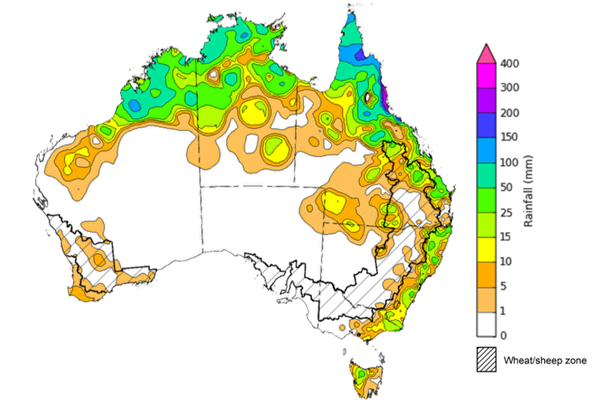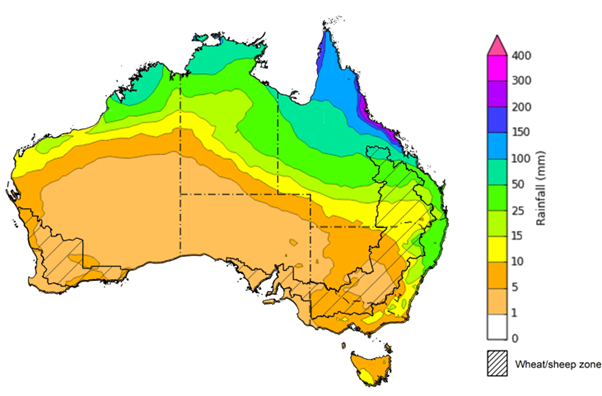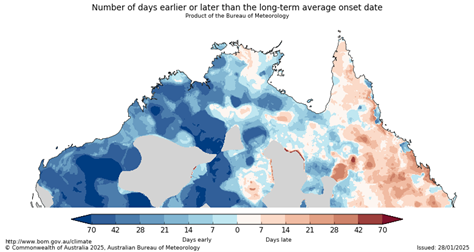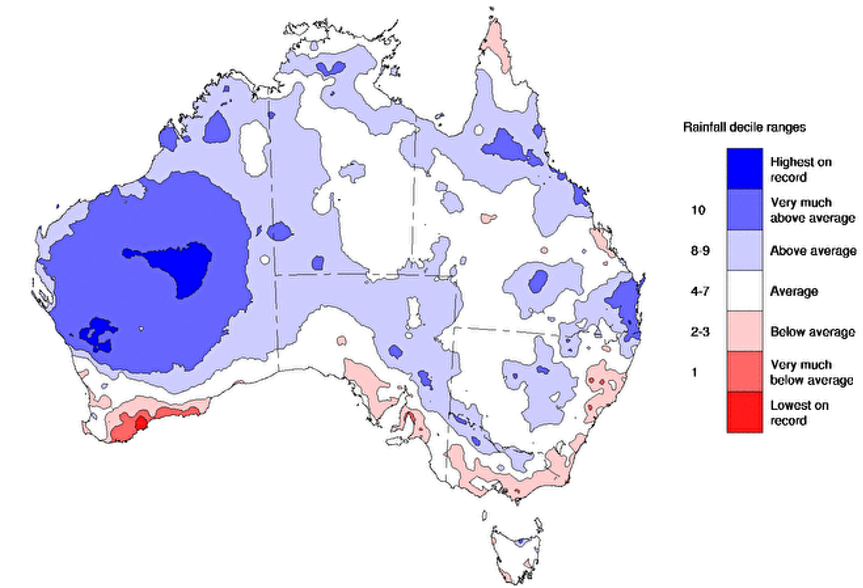Key issues
- In the week ending 29 January 2025, low-pressure systems brought rainfall to the north and east of Australia:
- Some rainfall was recorded across northern cropping regions, but falls were highly variable, with between 10–50 millimetres being recorded across parts of western and northern Queensland.
- Conditions across southern cropping regions were drier (receiving 0–10 millimetres).
- Over the coming eight days, low-pressure systems and troughs are expected to bring rainfall across the north and east of the country.
- Across cropping regions, Queensland is expected to receive up to 100 millimetres of rainfall, and northern New South Wales to receive up to 50 millimetres. Little to no rainfall is expected in other cropping regions.
- The northern rainfall onset was achieved earlier than normal across much of northern Australia despite a record late monsoon onset. This indicates sufficient and timely rainfall has been recorded across much of northern Australia, likely stimulating and supporting pasture production across many northern grazing regions.
- Water storage in the Murray-Darling Basin (MDB) decreased between 23-30 January 2025 by 452 gigalitres (GL). Current volume of water held in storage is 14,571 GL, 23% less than this time last year and equivalent to 65% of total storage capacity. Water storage data is sourced from the Bureau of Meteorology.
- Allocation prices in the Victorian Murray below the Barmah Choke increased from $156 on 23 January to $159 on 30 January. Prices are lower in regions above the Barmah choke due to the binding of the Barmah choke trade constraint.
Climate
In the week ending 29 January 2025, low-pressure systems and a series of troughs brought rainfall and storms to the north and east of the country, while the remainder of the country was largely dry.
- The northern tropics, including the Northern Territory and northern Western Australia recorded falls between 25–150 millimetres. Meanwhile, much of northern Queensland, recorded falls between 25–200 millimetres, with up to 400 millimetres in isolated coastal areas.
- Eastern Queensland, eastern New South Wales and Tasmania received between 0–50 millimetres of rainfall, while eastern Victoria received between 0–25 millimetres.
- South Australia, southern Western Australia, and central inland regions of Australia recorded little to no rainfall over the period.
Rainfall totals were generally low across cropping regions:
- Southern cropping regions received little to no rainfall. This included much of Western Australia, South Australia, Victoria, New South Wales, and southern Queensland which received between 0–10 millimetres.
- Parts of northern and south-western Queensland recorded slightly higher rainfall totals, with falls between 10–50 millimetres recorded across some regions.
- Despite the lack of rainfall across many summer cropping areas, most areas remain on track to record above average yield due to close to average soil moisture levels for this time of year.
Rainfall for the week ending 29 January 2025

Issued: 29/1/2025
Note: The rainfall analyses and associated maps utilise data contained in the Bureau of Meteorology climate database, the Australian Data Archive for Meteorology (ADAM). The analyses are initially produced automatically from real-time data with limited quality control. They are intended to provide a general overview of rainfall across Australia as quickly as possible after the observations are received. For further information go to http://www.bom.gov.au/climate/rainfall/
Over the 8 days to 6 February 2025, tropical lows and troughs are expected to bring rainfall and storms over the east and north of Australia:
- Falls between 10–100 millimetres are likely for much of northern Western Australia, and the Northern Territory. In northern Queensland, falls are expected to be higher, between 50 to 300 millimetres.
- Between 5–50 millimetres are forecast for much of New South Wales and southern Queensland, with falls between 5–15 expected in Victoria and Tasmania.
- By contrast, a high-pressure system is expected to keep much of the remainder of the south and interior of Australia largely dry, including South Australia and southern Western Australia.
Rainfall forecasts across cropping regions over the coming week are mixed:
- Low rainfall totals are expected in southern cropping regions, including across much of Western Australia, South Australia, Victoria, and southern and central New South Wales (between 1–10 millimetres).
- Higher rainfall is expected in northern cropping regions, with Queensland likely to receive between 10–100 millimetres. In northern New South Wales, falls between 10–50 millimetres are expected. Rainfall forecast for summer cropping regions in Queensland and New South Wales is likely to be sufficient to support average soil moisture levels and above average summer crop yield potentials.
Total forecast rainfall for the period 30 January to 6 February 2025

Issued 30/1/2025
Note: This rainfall forecast is produced from computer models. As the model outputs are not altered by weather forecasters, it is important to check local forecasts and warnings issued by the Bureau of Meteorology.
The timing of northern rainfall onset is an important indicator for seasonal pasture growth and potential livestock production. The rainfall onset indicates the accumulation of at least 50 millimetres of rainfall after 1 September to stimulate plant growth after the northern dry season.
The northern rainfall onset was achieved earlier than normal across large areas of northern Australia, despite record-late monsoon onset in 2024–25. Since 1 September 2024, large areas of northern Australia have received at least 50 millimetres of rainfall, and the northern rainfall onset was achieved early across northern parts of Western Australia, the Northern Territory and large areas of western Queensland.
Despite the delayed onset of the northern monsoon, sufficient and timely rainfall has been recorded across much of northern Australia, likely stimulating and supporting pasture production across many northern grazing regions.
Number of days earlier or later than the long-term average onset date

This is further supported by analysis of rainfall deciles between October-December 2024 which record average to above average rainfall across much of northern Australia. Isolated areas of Queensland saw below average rainfall over the period.
Rainfall deciles for the period 1 October to 31 December 2024

Water
Water storages, water markets and water allocations - current week
The Tableau dashboard may not meet accessibility requirements. For information about the contents of these dashboards contact ABARES.
Commodities
Information on weekly price changes in agricultural commodities is now available at the Weekly commodity price update.
